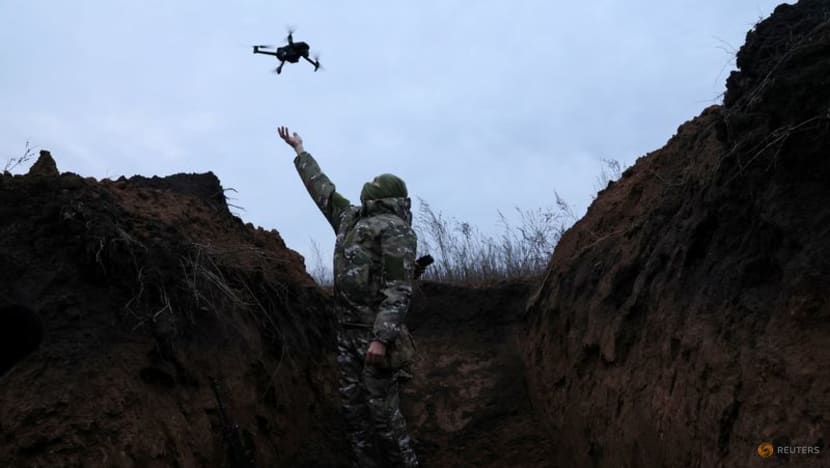Human-Machine Teams Driven by Ai are About to Reshape Warfare
Human-Machine teams, driven by AI, are set to reshape warfare through advanced technology integration and collaborative decision-making. This transformation will fundamentally alter the dynamics of warfare, enhancing both offensive and defensive capabilities.
As AI continues to advance, it enables machines to possess autonomous decision-making abilities, process vast amounts of data in real-time, and improve overall situational awareness. This exponential growth in AI capability will allow human operators to harness the power of machines, augmenting their decision-making processes and precision.
The collaboration between humans and machines on the battlefield will lead to more efficient and effective outcomes, revolutionizing modern warfare and creating new strategic opportunities.
Harnessing The Power Of Ai And Humans
Warfare is on the brink of transformation as human-machine teams driven by AI emerge. Discover how the power of AI and humans will reshape the future of warfare.
The harnessing of artificial intelligence (Ai) and human capabilities has the potential to revolutionize warfare as we know it. By integrating Ai technologies with human decision-making processes, we can unlock enhanced strategic advantages and unprecedented precision in the battlefield. In this section, we will explore how the power of Ai and humans can be harnessed to create formidable human-machine teams.
Enhanced Decision-Making Capabilities With Ai Integration:
- Ai integration enables real-time data analysis, allowing commanders to make informed decisions swiftly.
- By leveraging Ai’s ability to process vast amounts of data, human decision-makers gain timely insights.
- Ai algorithms can identify patterns and predict outcomes, assisting human commanders in planning military operations effectively.
- The combination of human intuition and Ai’s analytical abilities leads to superior decision-making, reducing the margin for error in critical situations.
The integration of Ai in warfare does not seek to replace human decision-makers but rather augment their capabilities. By embracing this partnership, we tap into the strengths of both humans and Ai, creating a synergy that can provide a significant advantage in complex military scenarios.
Leveraging human intuition and creativity combined with Ai’s analytical abilities:
- Humans possess innate intuition and creativity, enabling them to intuitively understand ambiguous situations.
- Ai’s analytical abilities complement human intuition, providing objective insights and data-driven recommendations.
- The collaboration of human creativity and Ai’s analytical capabilities allows for innovative problem-solving approaches.
- By combining human and Ai perspectives, military strategies can be developed with greater foresight.
The marriage of human ingenuity and Ai technology has the potential to unlock new possibilities in warfare. It empowers human decision-makers with enhanced information processing capabilities, enabling them to make better-informed choices. Furthermore, the synergy between humans and Ai fosters creativity and innovation, setting the grounds for agile and adaptive military operations.
The era of human-machine teams driven by Ai is upon us, with the power to reshape the future of warfare. By harnessing Ai’s analytical prowess alongside human intuition and creativity, we unlock unprecedented decision-making capabilities. This partnership between humans and Ai will enable military forces to navigate complex and evolving battlefields with strategic precision.
Together, they form an unstoppable force that will redefine the way wars are fought and won.

Credit: m.economictimes.com
Implications For Military Strategy And Operations
Ai-driven human-machine teams are set to revolutionize warfare, impacting military strategy and operations. With the potential for enhanced decision-making capabilities and increased efficiency, these teams will reshape the future of warfare and demand innovative approaches from the military.
Human-Machine Teams Driven By Ai Are About To Reshape Warfare
The emergence of artificial intelligence (AI) has paved the way for an unprecedented revolution in warfare. By combining human expertise with AI-powered machines, modern militaries are now able to harness the full potential of advanced technologies. This integration of human and machine capabilities has far-reaching implications for military strategy and operations, ushering in a new era of combat.
In this section, we will explore the strategies for utilizing human-machine teams in combat, the role of real-time data analysis and decision-making in the battlefield, and the challenges and considerations associated with implementing such teams.
Strategies For Utilizing Human-Machine Teams In Combat:
- Collaborative decision-making: Human-machine teams leverage the unique strengths of each member to enhance decision-making capabilities. By integrating AI algorithms with human intuition and experience, these teams can analyze complex scenarios, gather intelligence, and develop effective strategies in real-time.
- Skill augmentation: AI-powered machines can complement human skills by performing repetitive tasks, gathering and processing vast amounts of information, and providing real-time situational awareness. This allows human operators to focus on high-level decision-making and complex problem-solving.
- Human oversight and control: While AI-driven machines may operate autonomously to a certain extent, humans must retain control and serve as the ultimate decision-makers. This ensures accountability, ethical considerations, and the ability to adapt in dynamic environments.
Real-Time Data Analysis And Decision-Making In The Battlefield:
- Enhanced situational awareness: AI algorithms can rapidly process vast volumes of data and provide real-time insights, allowing commanders and operators to make informed decisions based on accurate and up-to-date information. This can greatly improve the effectiveness and efficiency of military operations.
- Predictive analytics: By analyzing historical data and patterns, AI systems can anticipate potential threats and outcomes, allowing for proactive decision-making and risk mitigation. This capability enables commanders to stay one step ahead of the adversary and optimize their strategies.
- Fast and precise response: Human-machine teams equipped with AI technologies can quickly analyze incoming data streams, identify trends, and generate actionable recommendations. This enables rapid and precise responses to changing battlefield dynamics, minimizing the potential for errors and maximizing operational effectiveness.
Challenges And Considerations For Implementing Human-Machine Teams:
- Trust and reliance: Building trust between human operators and AI-powered machines is crucial. Operators must have confidence in the capabilities and reliability of the technology, while understanding its limitations. Effective training and communication are essential for establishing trust and optimizing collaboration.
- Ethical considerations: AI technologies raise important ethical questions, particularly in the context of warfare. Issues such as accountability, proportionality, and adherence to international laws and norms must be carefully addressed to ensure responsible and ethical use of human-machine teams.
- Adapting organizational structures and processes: The integration of AI and human operators requires adjustments to existing military structures and processes. This includes redefining roles and responsibilities, establishing effective communication channels, and developing new training programs. Adaptation to these changes is crucial to fully realize the potential of human-machine teams.
The utilization of human-machine teams driven by AI will have significant implications for military strategy and operations. By embracing collaborative decision-making and real-time data analysis, armed forces can gain a competitive edge on the battlefield. However, addressing challenges such as trust, ethics, and organizational adaptations is essential for the successful implementation of these teams.
The effective integration of humans and AI technologies will pave the way for a future where warfare is shaped by the seamless interaction of human expertise and advanced machines.
Tactical Advantages Of Human-Machine Teams
The evolution of warfare is imminent as AI-powered Human-Machine Teams revolutionize tactical advantages. With AI driving these teams, the landscape of warfare is set to transform, introducing new levels of strategic capabilities and reshaping the way battles are fought.
As technology continues to advance, the use of artificial intelligence (AI) in warfare is becoming increasingly common. Human-machine teams, driven by AI, are poised to reshape the battlefield in unprecedented ways. These teams offer numerous tactical advantages that can greatly enhance military operations.
Let’s explore some of these advantages:
Increased Situational Awareness And Intelligence Gathering:
- Real-time data analysis and processing capabilities provide military personnel with a comprehensive view of the battlefield.
- Advanced sensors and surveillance technologies enable the identification and tracking of enemy movements, ensuring enhanced situational awareness.
- AI algorithms can rapidly process vast amounts of information, allowing for quick decision-making and more accurate intelligence gathering.
Enhanced Precision In Targeting And Weapon Systems:
- AI-powered targeting systems improve accuracy and reduce collateral damage, ultimately saving civilian lives during conflicts.
- Machine learning algorithms can analyze historical data to predict enemy behavior and optimize the effectiveness of weapons.
- Human-machine teams can leverage AI technology to anticipate threats, enabling preemptive strikes and giving commanders a significant advantage.
Improved Logistics And Supply Chain Management:
- AI algorithms assist in analyzing and optimizing supply chain logistics, ensuring timely and efficient delivery of resources to deployed units.
- Automation of routine tasks, such as inventory management, frees up the time of military personnel to focus on strategic decision-making.
- Predictive maintenance algorithms can be employed to identify potential equipment failures and minimize downtime, ensuring operational readiness.
By leveraging the power of AI, human-machine teams can revolutionize warfare by providing increased situational awareness, enhanced precision in targeting, and improved logistics and supply chain management. These tactical advantages enable military forces to operate more efficiently, minimize casualties, and gain a decisive edge on the battlefield.
As AI technology continues to evolve, we can expect even greater advancements in the capabilities and effectiveness of human-machine teams in future conflicts.
Ethical And Legal Considerations
Human-machine teams driven by AI have the potential to reshape warfare, leading to significant ethical and legal considerations. This transformative technology raises questions about the use of autonomous weapons and the potential for unintended consequences, calling for careful consideration of the moral and legal implications of AI-powered warfare.
Assessing The Ethical Implications Of Autonomous Systems In War
- The use of autonomous machines in warfare raises various ethical concerns that need careful assessment.
- Ethical considerations include:
- The potential for increased civilian casualties due to the lack of human judgment and emotions in AI.
- The responsibility for the outcome of actions taken by autonomous systems.
- The moral implications of delegating life-and-death decisions to machines.
- The risk of unintended consequences or unforeseen ethical dilemmas arising from AI’s independent decision-making capabilities.
- The potential for AI to reduce the value of human life in warfare by desensitizing the human decision-making process.
Ensuring Compliance With International Humanitarian Law
- When employing human-machine teams in warfare, it is crucial to ensure full compliance with international humanitarian law to protect civilians and minimize unnecessary suffering.
- Compliance measures include:
- Predefined rules of engagement that align with international legal standards.
- Regular audits and assessments to ensure adherence to the rules of war.
- Continuous monitoring and evaluation of AI systems to prevent ethical and legal violations.
- Implementing safeguards to prevent malicious use or unintended harm caused by autonomous systems.
- Establishing clear channels for reporting and investigating any potential violations.
The Role Of Human Oversight And Accountability In Human-Machine Teams
- Human oversight and accountability play vital roles in the use of human-machine teams for warfare to maintain ethical standards and address any shortcomings.
- Key considerations are:
- Assigning human operators to oversee and intervene, if necessary, in the actions of autonomous systems.
- Establishing robust mechanisms for human-machine interaction to ensure effective collaboration and control.
- Implementing thorough training programs to enable human operators to understand and manage the capabilities and limitations of AI systems.
- Holding individuals responsible for the decisions made and actions taken by autonomous systems under their supervision.
- Promoting transparency and public awareness regarding the use and limitations of human-machine teams in warfare.
As human-machine teams driven by AI continue to evolve and reshape warfare, it is imperative to assess the ethical implications of autonomous systems, ensure compliance with international humanitarian law, and establish effective human oversight and accountability. By addressing these considerations, we can strive to strike a balance between leveraging the benefits of AI technology and upholding ethical values in the context of warfare.
Addressing The Technical Challenges
AI-driven human-machine teams are set to revolutionize warfare by addressing technical challenges. These teams will reshape the future of warfare by leveraging advanced technologies and enhancing operational capabilities.
The integration of AI systems with existing military infrastructure presents significant technical challenges. These challenges include:
- Interoperability: Ensuring seamless communication and compatibility between AI systems and existing military hardware and software.
- Training and Adaptability: Developing AI models that can quickly adapt to new scenarios and learn from real-time data in order to enhance decision-making capabilities.
- Situational Awareness: Implementing AI systems that can analyze vast amounts of data to provide accurate and timely situational awareness to commanders and troops on the ground.
- Real-time Processing: Overcoming the challenge of processing large amounts of data in real-time to support tactical decision-making during fast-paced military operations.
- Connectivity and Communication: Establishing robust communication networks that can support the transfer of data between AI systems and other military assets.
To address these challenges, it is crucial to pay attention to cybersecurity and protect critical systems from potential attacks. Cybersecurity measures should be implemented at all levels to safeguard AI systems and ensure the integrity of military operations.
Other technical challenges that need to be addressed include managing data overload and ensuring data integrity. With the increasing use of AI in warfare, the amount of data generated can be overwhelming. It is essential to have efficient data management systems in place to process, analyze, and derive actionable insights from this data.
Additionally, data integrity must be maintained to ensure the reliability and accuracy of AI-generated information.
Addressing the technical challenges of integrating AI systems into military infrastructure involves ensuring interoperability, training and adaptability, situational awareness, real-time processing, and robust connectivity. Furthermore, cybersecurity measures, data management, and data integrity are crucial aspects that need to be addressed to ensure the effective use of AI in reshaping warfare.
The Future Of Warfare: Human-Machine Collaboration
The future of warfare is being reshaped by AI-driven human-machine collaboration. Human-machine teams are set to revolutionize warfare, with artificial intelligence playing a crucial role in enhancing capabilities and effectiveness on the battlefield. Brace yourself for an unprecedented era of warfare where humans and machines work together as an unstoppable force.
Today, the world stands on the brink of a new era of warfare – one where human capabilities are augmented by cutting-edge Ai technology. As we embrace this evolution, the landscape of warfare is set to transform in ways we never thought possible.
Human-machine teams are poised to reshape the very nature of conflict, requiring us to adapt military doctrines and reevaluate defense strategies. We delve into the future of warfare, focusing on the powerful concept of human-machine collaboration.
Augmenting Human Abilities With Ai Technology:
- Enhanced intelligence gathering: Ai-driven systems can process vast amounts of data in real time, allowing for more effective intelligence gathering and analysis.
- Improved situational awareness: Machine learning algorithms, combined with sensor technologies, enable soldiers to quickly assess complex battlefield situations and make informed decisions.
- Precision strikes: Ai-powered weapons systems can significantly enhance the accuracy and effectiveness of attacks, reducing collateral damage and increasing mission success rates.
- Logistics optimization: Ai algorithms can optimize the planning and execution of supply chains, ensuring timely and efficient delivery of crucial resources to forces on the ground.
- Risk reduction: By leveraging Ai capabilities, the risk to human lives can be minimized, as machines can undertake tasks that are dangerous or too challenging for humans.
Potential Impact On Defense Industry And Resource Allocation:
- Increased research and development: The rise of human-machine teams will drive substantial investment in Ai technologies, spurring advancements and innovation within the defense industry.
- Shift in resource allocation: With the growing significance of Ai-powered systems, defense budgets may reallocate resources towards Ai research, development, and implementation.
- Job evolution: The integration of Ai in warfare may impact traditional military roles, as the demand for personnel with Ai expertise increases, leading to the evolution of new specialized positions.
- Training and skill development: Military establishments will need to prioritize training programs that focus on developing the necessary skills to effectively collaborate with Ai systems.
Adaptation And Evolution Of Military Doctrines With The Rise Of Human-Machine Teams:
- Redefinition of tactics and strategies: The emergence of human-machine teams will necessitate a reevaluation of existing military doctrines, incorporating new tactics and strategies that capitalize on the strengths of both humans and machines.
- Ethical considerations: The use of Ai in warfare raises ethical questions that demand careful consideration. International agreements and guidelines will be essential to ensure responsible and ethical deployment.
- Collaboration between humans and machines: Effective human-machine collaboration requires the development of protocols and procedures that enable seamless interaction and coordination between humans and Ai systems.
- Continuous evolution: As Ai technologies evolve, military doctrines must be fluid and adaptable, embracing innovation and adjusting to the evolving capabilities of human-machine teams.
The path towards human-machine collaboration in warfare holds immense potential but also numerous challenges. By augmenting human abilities with Ai technology, we can enhance intelligence gathering, improve situational awareness, optimize logistics, and reduce risks. The impact on the defense industry will be significant, leading to resource reallocation and a shift in job roles.
As military doctrines adapt and evolve, considering the ethical implications and fostering seamless collaboration between humans and machines will be paramount. The future of warfare hinges on our ability to harness the power of human-machine teams, and the possibilities that lie ahead are both exciting and daunting.
Frequently Asked Questions For Human-Machine Teams Driven By Ai Are About To Reshape Warfare
What Is The Role Of Ai In Reshaping Warfare?
AI is playing a crucial role in reshaping warfare by enabling human-machine teams. It enhances decision-making, automates tasks, improves accuracy, and provides valuable intelligence for more efficient and effective combat operations.
How Do Human-Machine Teams Function In Warfare?
Human-machine teams in warfare combine the strengths of humans and AI. Humans provide judgment, creativity, and contextual understanding, while AI offers data analysis, pattern recognition, and real-time insights. Together, they work collaboratively to achieve superior outcomes in a rapidly changing battlefield environment.
Can Ai Replace Human Soldiers In Warfare?
No, AI cannot completely replace human soldiers in warfare. While AI can augment human capabilities, it lacks empathy, moral judgment, and the ability to adapt to complex and unpredictable situations. Human soldiers are essential for making critical decisions and exhibiting qualities like compassion, intuition, and adaptability in the battlefield.
Conclusion
With the rapid advancements in artificial intelligence, it is clear that human-machine teams will play a significant role in reshaping warfare. As military technologies continue to evolve, the integration of AI into military operations will enhance decision-making capabilities, improve response times, and increase overall efficiency.
The ability of AI systems to process massive amounts of data and analyze complex scenarios will provide commanders with invaluable insights to make better-informed decisions on the battlefield. Furthermore, the collaboration between humans and AI can potentially reduce the risks faced by human military personnel.
However, it is important to recognize the ethical and legal concerns associated with the use of AI in warfare and develop appropriate safeguards and regulations to ensure responsible implementation. While there are still challenges to overcome, the potential benefits offered by human-machine teams driven by AI are undoubtedly transformative, promising a new era of warfare that combines the strengths of both man and machine.














Post Comment